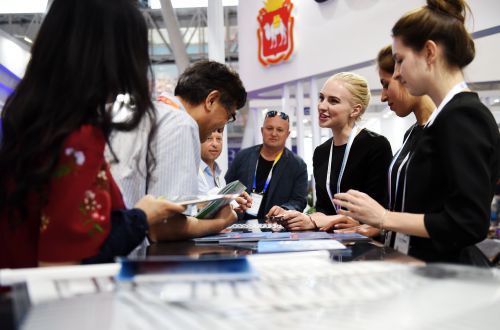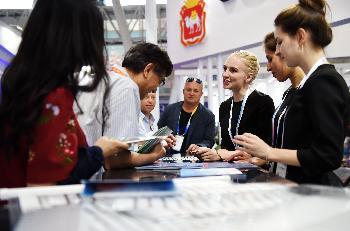
(People attending the 4th China-Russia Expo held in Harbin, northeast China's Heilongjiang province)
HARBIN, June 19 (Xinhua) -- After a summer rain, Qiu Xianglin likes to grab his camera and takes a walk along the Heilongjiang River, which serves as a boundary between China and Russia. If a rainbow stretches over the river between China's Heihe city and the Russian city of Blagoveshchensk, he is thrilled for days.
"Because it is the most beautiful picture in my heart," says 74-year-old Qiu, who was the chief photojournalist for the Heihe Daily before he retired. For 40 years, he recorded the changes of China-Russian economic and trade cooperation, taking over 100,000 photos.
"Water melons in exchange for chemical fertilizers" is one of his most famous works. It was taken in September 1987, shortly after trade through Heihe Port was resumed.
"Our side traded 208 tonnes of water melons for over 300 tonnes of much-needed fertilizers from them," he says.
Over the years there was much trading between the two sides and Qiu saw a lot of it first hand.
"Heihe's people-to-people trade with the USSR was the most dynamic, a scene you would never see in other Chinese places," Qiu says. "The central street was filled with wheeler-dealers who traded sportswear with the Soviets for wool coats."
China's light industrial products such as clothing, shoes and hats were very popular on the other side, while Soviet leather and metal products won the hearts of Chinese.
In order to satisfy the needs of both sides, the first economic and trade fair between China and the USSR as well as eastern European countries was held by the former Ministry of Foreign Trade and Economic Cooperation (now the Ministry of Commerce) and the provincial government of Heilongjiang in Harbin in 1990.
"Barter trade was basically the major mode of doing business, which was the precursor of Harbin international trade fair," says Qiu, who took many pictures of the event.
"Three middle-aged men with hands clasped behind back, bending over and concentrating on crafts made of birch," is a photo taken at the 23rd Harbin international trade fair in 2012, and the photographer was Qiu Qilong, son of Qiu Xianglin.
After the dissolution of the Soviet Union, the Harbin international trade fair underwent several changes before taking its final shape, focusing on Russia.
Qiu Qilong followed his father's path, continuing to photograph Harbin international trade fairs every year.
In 2014, the 25th Harbin international trade fair was upgraded to the China-Russia Expo. Also this year, Qiu Guodong, 19, bid farewell to his hometown Heihe, leaving to study at Heilongjiang Institute of Technology in Harbin.
Under the influence of his father and grandfather, youngest Qiu has been recording "China-Russia friendship" since he was a child. Fluent in Russian, he had a special feeling towards the country.
"My father often talked to me what the trade fair looked like, but what I saw in person was wildly different."
Stepping into the Harbin international convention center, where the ongoing fourth expo is held, left him shocked.
A model of China's manned submersible Jiaolong, an unmanned plane, nanotechnology, graphene, such cutting-edge exhibits changed his idea of China-Russian cooperation.
He even did some research on cross-border e-commerce between China and Russia.
"College students are encouraged to start their own business, and I think my hometown has some advantages," he said.
This year's expo, which opened Thursday, also aims to expand common ground for the building of the Belt and Road Initiative and the Eurasian Economic Union. Merchants and government officials from 74 countries and regions participated.
After another summer rain, grandfather Qui takes a walk along Heilongjiang River as usual, though there is no rainbow in sight, he raises his camera and takes a picture of a bridge being built. It will connect Heihe and Blagoveshchensk, and bring the twin cities even closer.




 A single purchase
A single purchase









